Willems, Mo. Knuffle Bunny. New York: Scholastic, 2005. Print.
Little Trixie and her father go to do laundry at the local laundry mat, but after Trixie leaves she realizes that she left her knuffle bunny behind.
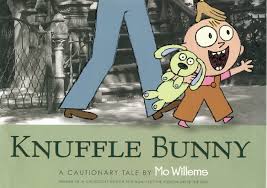 This book was a Caldecott honor book which we learned in class was awarded to the most outstanding children’s illustrations in a children’s book. I selected five picture books that received either the Caldecott Award or the Caldecott Honor. This book was the newest one I selected; it only won an honor even though the artist did something that I felt was rather original. He seemed to have drawn cartoon characters, like Trixie and her father, but then he placed them in real backgrounds like the Laundromat and the apartment building. I felt like this was a very unique and artistic idea, something that I have not seen very often. The artist was able to blend the real world together with the cartoon world and it makes the simplistic story much more interesting. The cartoon characters are brought to life through the real world backgrounds, and it really made me want to stop reading the text and just study the pictures because it was something that I had never seen before.
This book was a Caldecott honor book which we learned in class was awarded to the most outstanding children’s illustrations in a children’s book. I selected five picture books that received either the Caldecott Award or the Caldecott Honor. This book was the newest one I selected; it only won an honor even though the artist did something that I felt was rather original. He seemed to have drawn cartoon characters, like Trixie and her father, but then he placed them in real backgrounds like the Laundromat and the apartment building. I felt like this was a very unique and artistic idea, something that I have not seen very often. The artist was able to blend the real world together with the cartoon world and it makes the simplistic story much more interesting. The cartoon characters are brought to life through the real world backgrounds, and it really made me want to stop reading the text and just study the pictures because it was something that I had never seen before. 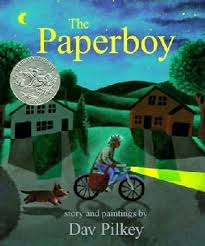
Pilkey, Dav. The Paperboy. New York: Orchard Books, 2004. Print.
This book is all about the work of a child who works as a paperboy for extra money, he must wake up early and deliver the newspaper to the rest of the community, and when they finally wake up, he's falling back to sleep.
This book was a Caldecott Honor Award and what I loved so much about this book was the illustrator's ability to effectively convey to his audience the weather and time of the story. The pictures made me think about the times that I have had to get out of bed before the sun rises and how cold it is, but you still must awake, get ready, and walk out of the house in the freezing night air to accomplish a certain task. In other words, the illustrations found in this book really add to the story and it makes the reader put themself in that situation. Then by the end of the paperboy's route, when the sun is finally rising, the illustrations almost make you smell the morning dew on the grass and feel the warming sun as it strikes your cold body and slowly warms you. One of the certain pictures really stood out to me as my favorite, when the little boy is on his bike and you can barely see him because the whole picture is taken up by the buildings of the entire city, it really makes it seem like the artist is trying to remind his audience how small we are in the grand scheme of things but how effective we can be if we work together.
Rohmann, Eric. My Friend Rabbit. New York: Scholastic, 2002. Print.
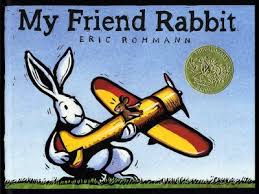 This book is about a rabbit that means well, but every time he helps his fellow creatures, trouble ends up not too far behind.
This book is about a rabbit that means well, but every time he helps his fellow creatures, trouble ends up not too far behind. This book won the Caldecott Award in 2003, it is a picture book with almost no text, but I am sure that children love the wonderful illustrations of all the different animals. By the end of the book, a rabbit and mouse end up riding on an airplane together but they end up getting stuck in a tree. I thought of a fun activity that could be done with a class after reading this book, especially in an early primary classroom. Each child could color and cut out a mask of their favorite animal and could wear them around for all the other children in the class to see. Then one kid could make a mask of a rabbit that wants to help all the other animals, this could build good teamwork and social skills among the students. The teacher could even build an airplane for the rest of the students and get it stuck somewhere in the room and the children, with their masks on of course, would have to find the hidden airplane and the winner would get a small prize or a treat. I think there are a lot of different activities that could go along with this book, it has great illustrations and I believe children would really love it.
Shannon, David. No, David. New York: Scholastic, 1998. Print.
This picture book is about a child named David who is always getting told not to do certain things or activities, not until he finds the right one.
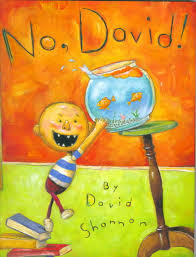 I thought this book would be a perfect one to read to early primary students because they probably feel like every time they do something at home their mom and dad are always telling them not to do it, they're doing it wrong, or they're not doing it fast enough. This picture book would let the students know that they're not the only kids in the world that are being told no by their parents. This book has wonderful illustrations that would really help a student be able to put themselves in the same situations that David gets into, like: reaching for the cookies on the top shelf, tracking in mud from outside, playing with their food instead of eating it, chewing with their mouth open, or jumping on their bed. This book was a Caldecott Honor Award book and even though it didn't win the award, it contains beautiful illustrations that really capture the eye. The artist did a wonderful job of drawing David with very mischievous-looking qualities that indicate to the reader that this child is ready to cause problems, but at the very end when he gives his mother a huge hug, he looks like the most well behaved boy.
I thought this book would be a perfect one to read to early primary students because they probably feel like every time they do something at home their mom and dad are always telling them not to do it, they're doing it wrong, or they're not doing it fast enough. This picture book would let the students know that they're not the only kids in the world that are being told no by their parents. This book has wonderful illustrations that would really help a student be able to put themselves in the same situations that David gets into, like: reaching for the cookies on the top shelf, tracking in mud from outside, playing with their food instead of eating it, chewing with their mouth open, or jumping on their bed. This book was a Caldecott Honor Award book and even though it didn't win the award, it contains beautiful illustrations that really capture the eye. The artist did a wonderful job of drawing David with very mischievous-looking qualities that indicate to the reader that this child is ready to cause problems, but at the very end when he gives his mother a huge hug, he looks like the most well behaved boy. Keats, Ezra. The Snowy Day. New York: Viking Press, 1962. Print.
This last book is about a little boy who greatly enjoys playing outside with his friends when it snows, but after his dream, he is not really sure if it is actually snowing outside or not.
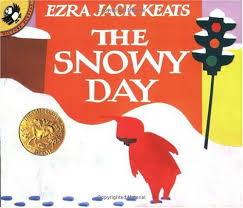 This book won the Caldecott Award in 1963, it is nearly 40 years older than the other four books that I decided to review. I thought it would be interesting to compare an award winner from the 1960's to an award winner in the late 1990's or even the 2000's. Out of the other four books that I reviewed only one actually won the Caldecott award but all were at least nominated for the award. But in my opinion all four of those books had a lot better illustrations than the ones found in the award winner for 1963, it really showed me how far children's picture books, and more specifically illustrations, have come in the last couple decades. Back in the 1960's picture books were not nearly as popular as they are in today's classroom, they are a great way to teach children not only how to read but also to develop in themselves a love for reading. The pictures in this last book were so simplistic and easy, they did not really add to the story like the illustrations in the other picture books and they did not make me want to stop and study them. If we have made this much progress over the last couple decades, I am very curious to see what will happen over the next forty years.
This book won the Caldecott Award in 1963, it is nearly 40 years older than the other four books that I decided to review. I thought it would be interesting to compare an award winner from the 1960's to an award winner in the late 1990's or even the 2000's. Out of the other four books that I reviewed only one actually won the Caldecott award but all were at least nominated for the award. But in my opinion all four of those books had a lot better illustrations than the ones found in the award winner for 1963, it really showed me how far children's picture books, and more specifically illustrations, have come in the last couple decades. Back in the 1960's picture books were not nearly as popular as they are in today's classroom, they are a great way to teach children not only how to read but also to develop in themselves a love for reading. The pictures in this last book were so simplistic and easy, they did not really add to the story like the illustrations in the other picture books and they did not make me want to stop and study them. If we have made this much progress over the last couple decades, I am very curious to see what will happen over the next forty years. 



No comments:
Post a Comment